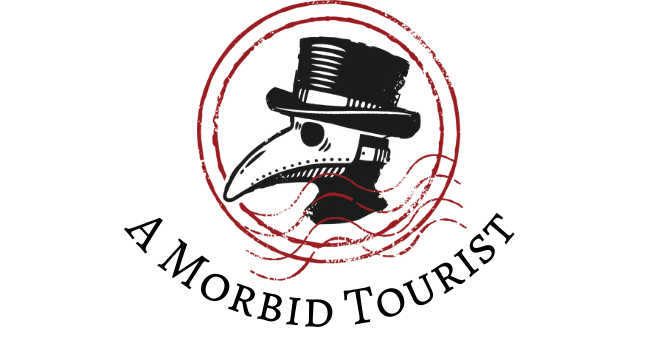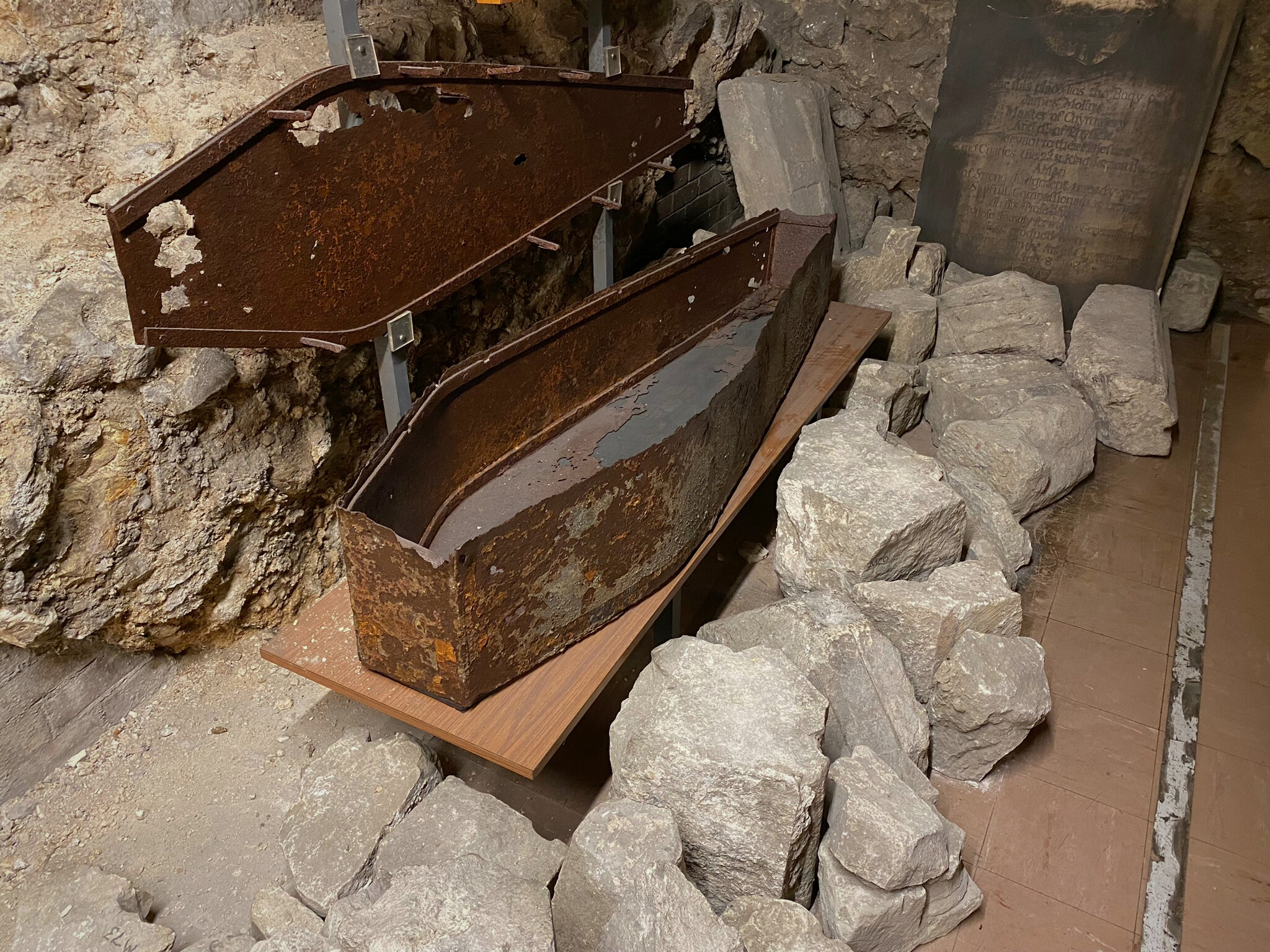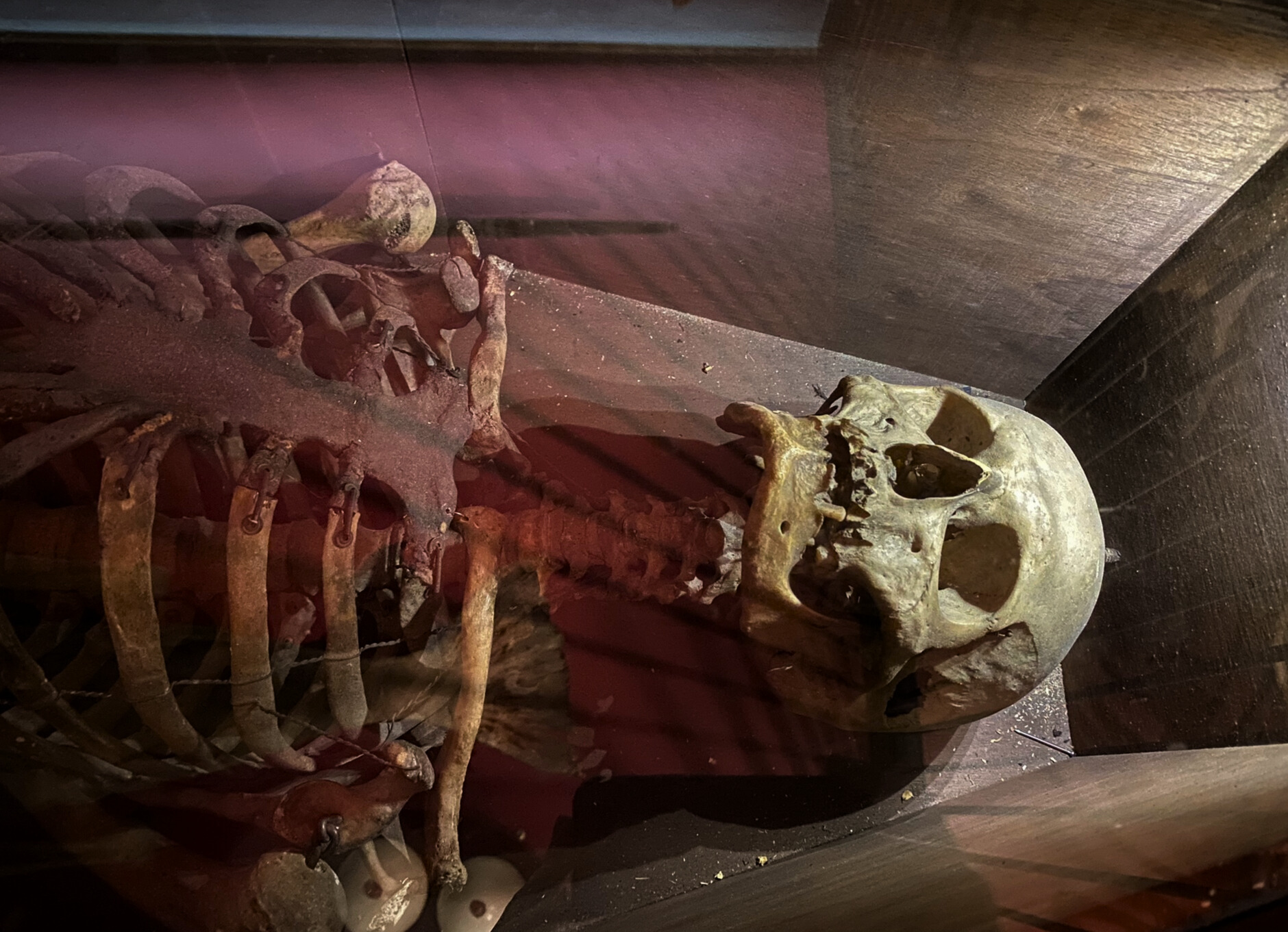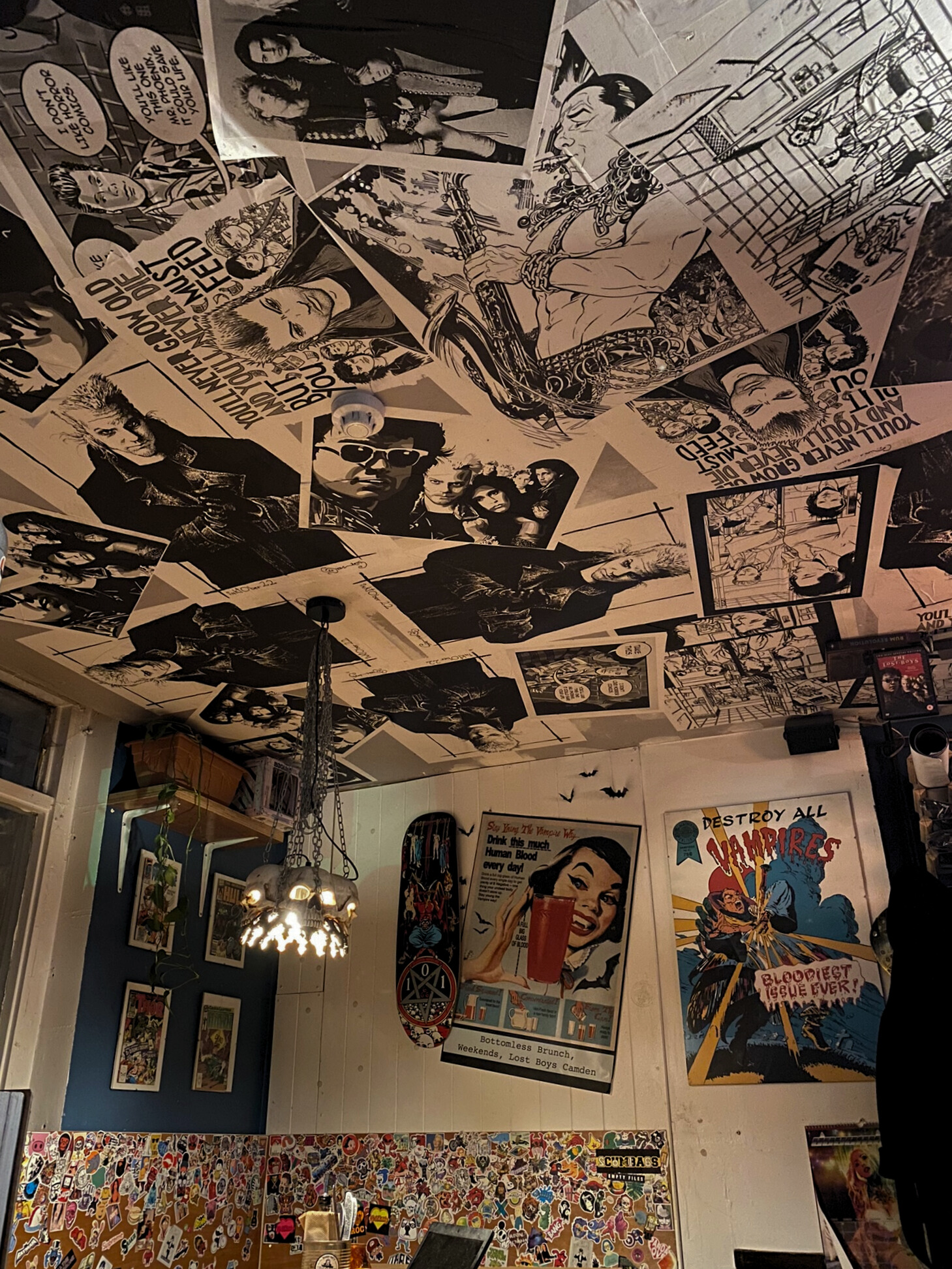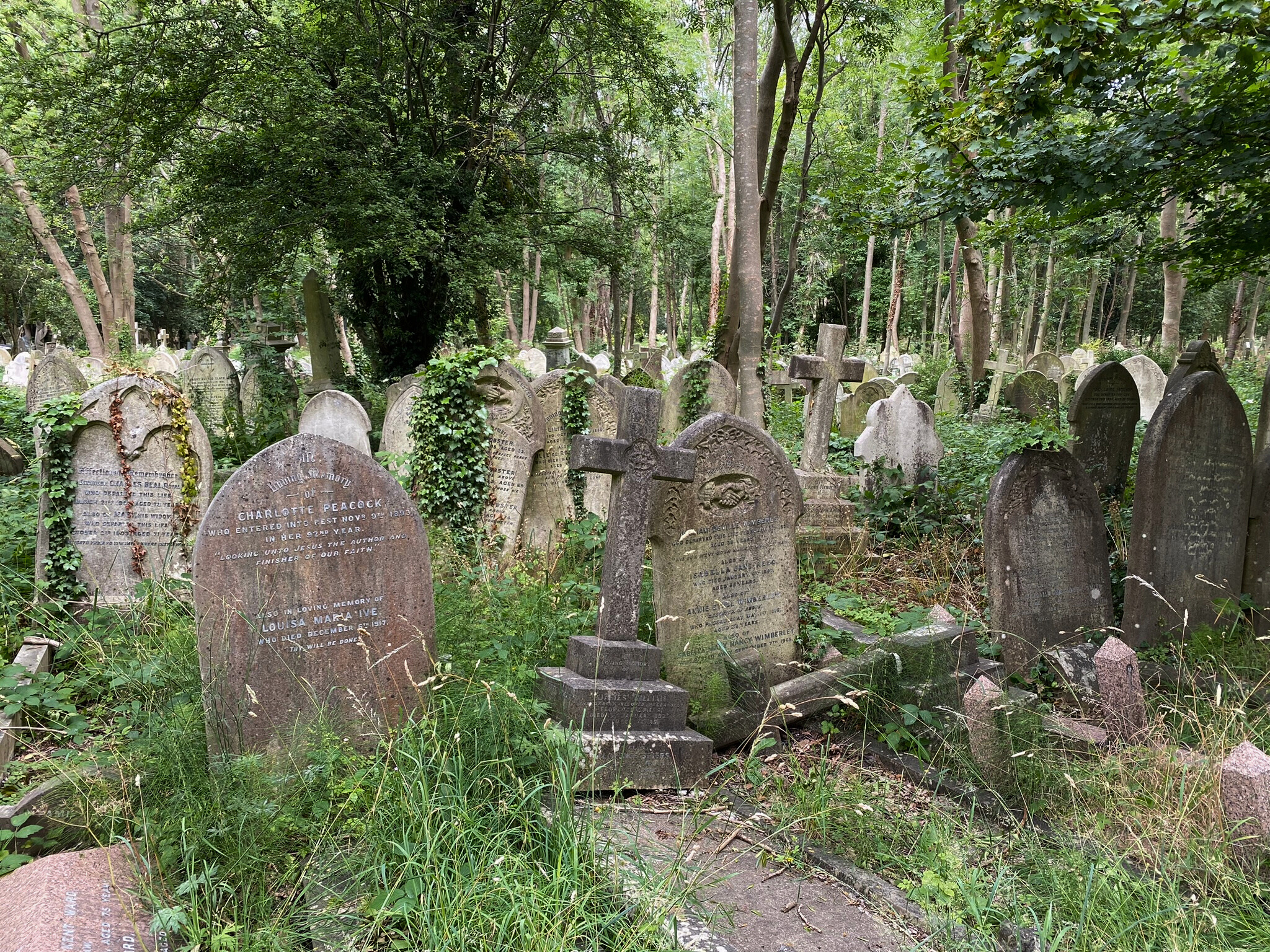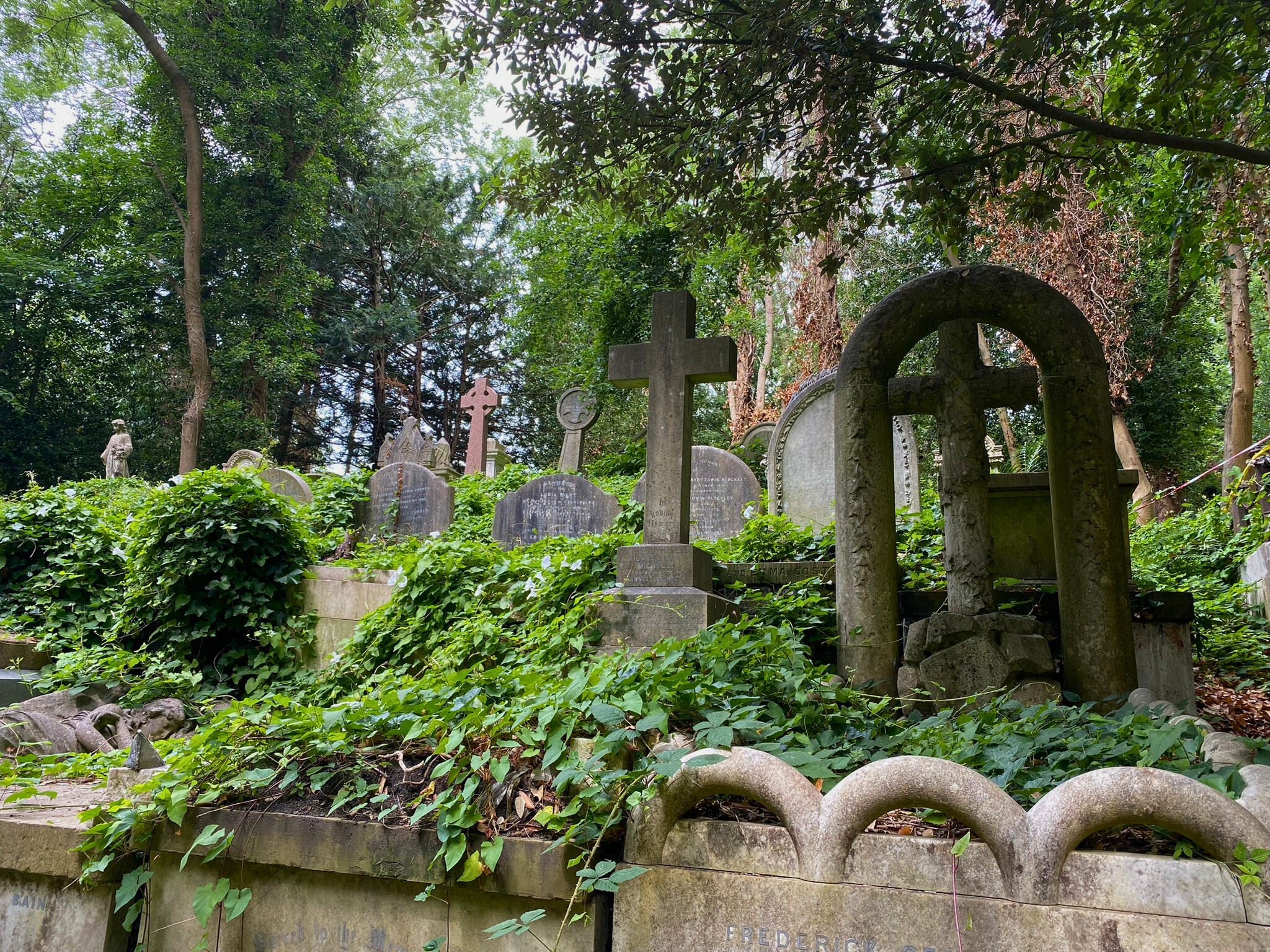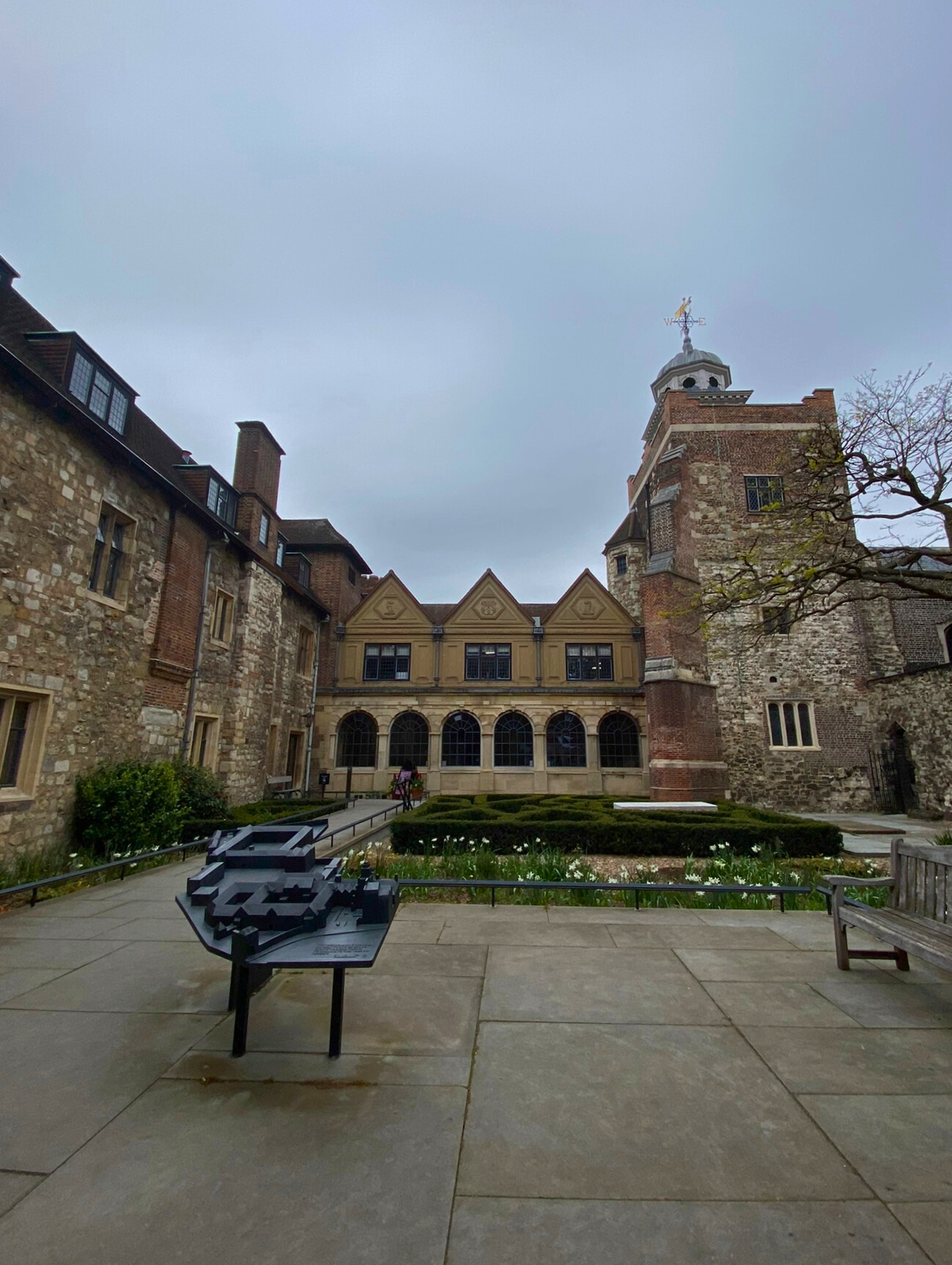St. Bride's Church:
The Ripper, The Fires, and a Wedding Cake
St. Bride’s Church sits on Fleet Street, set back behind a row of shops and cafes. You can access the front doors by coming off of the main street onto Salisbury Court, and then finding St. Bride’s Passage. The passage is a little alleyway in between two buildings that spits you out right in front of the huge wooden doors.
You have to crane your neck all the way to try to see the very top of the steeple. It has an immediate, imposing effect.
Hold onto your hats, morbid tourists, this one has a lot of lore!
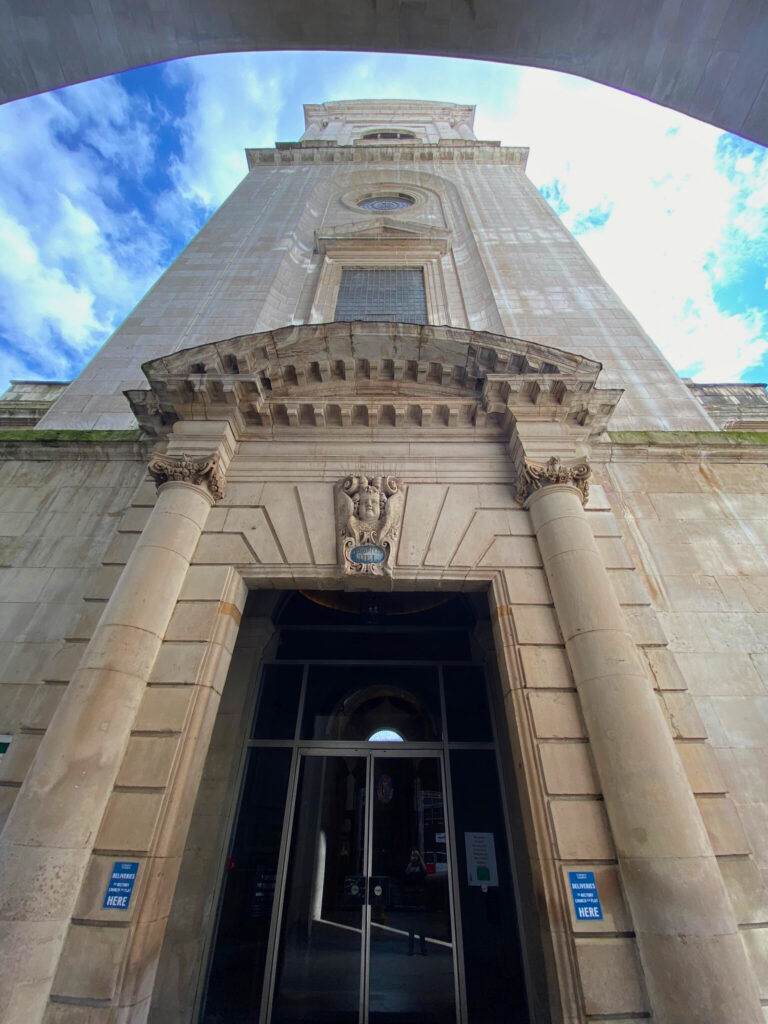
The site itself has been a sacred place or church for over 2000 years! Roman, Celtic Christianity, Saxon, and Norman churches have all existed there previously. At their last count, St. Bride’s themselves say that 8 separate churches have lived on this site. And that’s as far as we know.
Burns & War Wounds
This means that St. Bride’s was standing when a variant of the bubonic plague hit London in the 1660s. Apparently, during one particularly bad week, 238 parishioners at St. Bride’s died from it. Wow.
The Great Fire of London broke out in 1666 (cheeky number of the beast in the year – truth really is stranger than fiction). A silver lining to such an awful disaster is that it cut short that recurrence of the plague. However, St. Bride’s was one of 88 churches that burned down in the fire.
Sir Christopher Wren (yes, the one who did St. Paul’s Cathedral) designed the new St. Bride’s church after the fire. Its main, and arguably most stunning, feature was the wonderful tiered steeple design. This steeple is said to have inspired the very first tiered wedding cake, which has become the traditional shape. Fun fact: The steeple was only completed in 1703, despite the rest of the church already being done by 1675.
During the Blitz in the Second World War, poor old St. Bride’s was heavily damaged again. Incendiary bombs sent fire blazing through the church, gutting the insides. The outer walls and iconic Wren steeple luckily survived, and Sir Christopher’s original design was honoured in the post-war reconstruction.
The Ripper Comes to Town
In the late 1800s, the printing industry was beginning to drift away from Fleet Street (where it was first established), but the street and surrounding area were still hectic and busy. There were still plenty of shops and cafes for people to visit, and let’s face it… It’s central London. It’s always been packed.
To get a good idea of the Victorian charm, I found this photo from the time to illustrate:

This period was also when the notorious Jack the Ripper was stalking Whitechapel at night. In 1888, he murdered 5 women (at least) in and around the Whitechapel area. These unsolved crimes have a solid, and incredible, connection to St. Bride’s Church.
The Murder of Mary Ann
From what the cops have pieced together, Mr. the Ripper’s first canonical victim was a lady named Mary Ann Nichols. She was sometimes known as Polly. After a fairly awful divorce, Mary Ann lost her way a bit. Leaving her children in the care of her ex, she fell into crime – she got booked several times for minor offences like disorderly conduct and prostitution.
After that, her ex-husband stopped paying her an allowance, so Ms Nichols was in and out of the workhouse, too. This sad cycle continued, with Mary Ann living off of her earnings from sex work and falling deeper into the bottle.
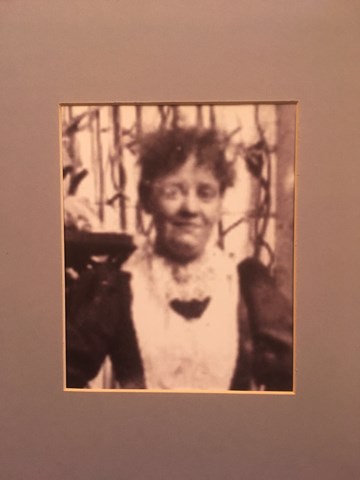
On the night of her murder, Mary Ann had been slung out of her lodgings for non-payment. To get her doss money, she walked the streets again. The last person to see her alive reported that Ms Nichols was visibly intoxicated, and commented that she’d earned the money for her digs twice over. However, she then drank it all away. If only she’d gone home the second she made enough cash.
Jack the Ripper made quick work of her, killing her by cutting her throat. I won’t detail the post-mortem mutilation he inflicted on Mary Ann, but it was extensive and awful. Her body was found, it was believed, only half an hour after she’d died. She was 150 yards from a hospital. It’s just bloody tragic, man.
The Whitechapel Connection
Amazingly, it turns out that Ms Nichols was born in the parish of St. Bride’s, and was a regular attendee at services. She was even married there in 1864, less than a quarter century before her tragic end.
St. Bride’s have honoured Mary Ann ever since, taking on the responsibility of keeping her memory alive. They make sure to show the humanity of Ms Nichols, reminding us that she was a whole person, not just a name lost in the furore that the Jack the Ripper case caused. This memorial also nudges us to have sympathy for an imperfect victim – whatever mistakes she had made, she didn’t deserve such a brutal, undignified death.
A plaque at the front door of St. Bride’s reads: Remember her life, not its end. So I did just that, spending a moment in the vestibule to think about her.

Oak & Gilded Charm
When you step through the second set of doors, the first thing you will notice is the altar, with the enormous oak reredos looming behind it. Behind those, your eye naturally travels up to the back wall, where a beautiful painting of a heavenly choir adorns the seemingly-domed wall. I’ll tell you, it’s mindblowing when you realise that the top of the wall actually isn’t curved at all!
The painting – created by Glyn Jones in 1957 – is what’s known as a trompe-l’œil (French, literally meaning ‘deceives the eye’). This amazingly skilled art technique, which is done by manipulating perspective, creates the optical illusion of a completely flat wall being curved. It also makes the flat image of the painting appear dynamic and three-dimensional. It really is clever, and wonderful to look at.
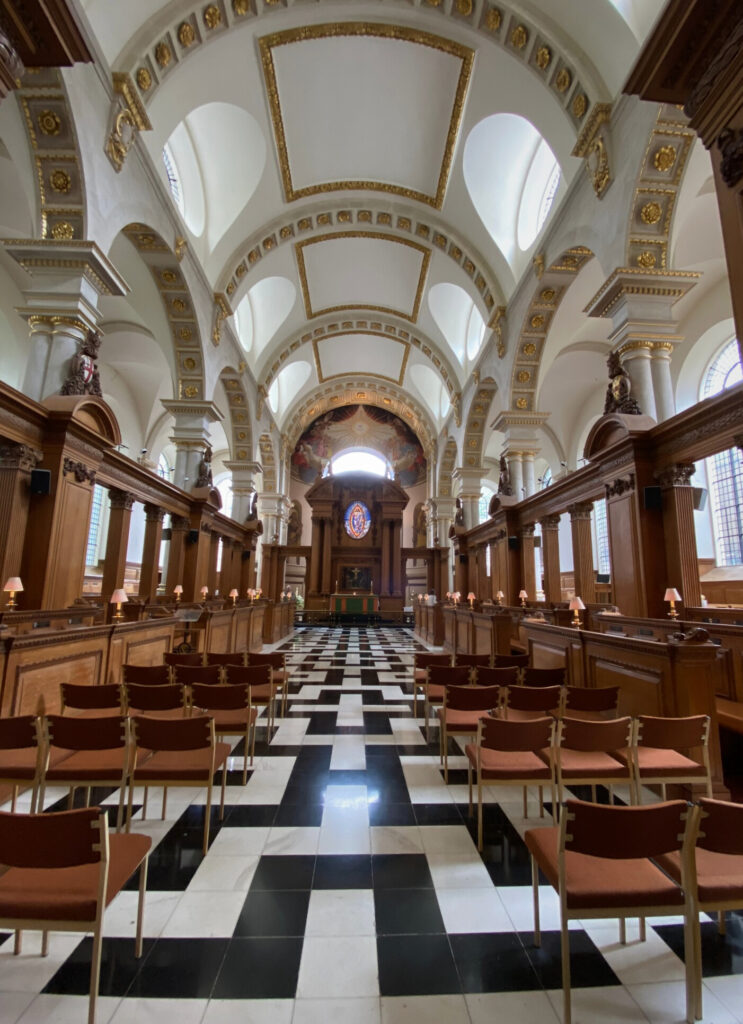
From this same spot at the rear of the nave, you can see many of the hallmarks of Wren’s original designs. For example: the symmetry and clean lines, the bold black-and-white marbled floor, and the emphasis on natural light are all very Wren-esque features. There are delicate gilded patterns on the ceilings and columns, and the rounded windows give the whole place a very soft, inviting look.
I was momentarily frozen in place by how neat and well-kept St. Bride’s looks. It’s a beautiful church, with a calm aura that feels deeply spiritual (even to me, an agnostic with no religious affiliation).
The Room Full of Bones
Another reason I’d wanted to visit St. Bride’s was because I heard they had an ossuary there. For the uninitiated, an ossuary is a room in which many people’s skeletons are kept. Sometimes it’s a jumble of random bones, other times they’re arranged into beautiful patterns, placed into rows, or even made into chandeliers. An ossuary is made when burial space is scarce, but also when a mass death has occurred – be it from war, mass starvation, or plague.
While Christopher Wren was rebuilding St. Bride’s after the Great Fire, he unearthed the two medieval charnel houses beneath. He made the decision to consolidate all of the remains into one crypt. That crypt continued to collect bones until the cholera outbreak of 1854, in which the government decided that all crypts like the one at St. Bride’s needed to be sealed. They said it was to stop further spread of disease, apparently not knowing that cholera dies without a host.
And that was that for almost a century.
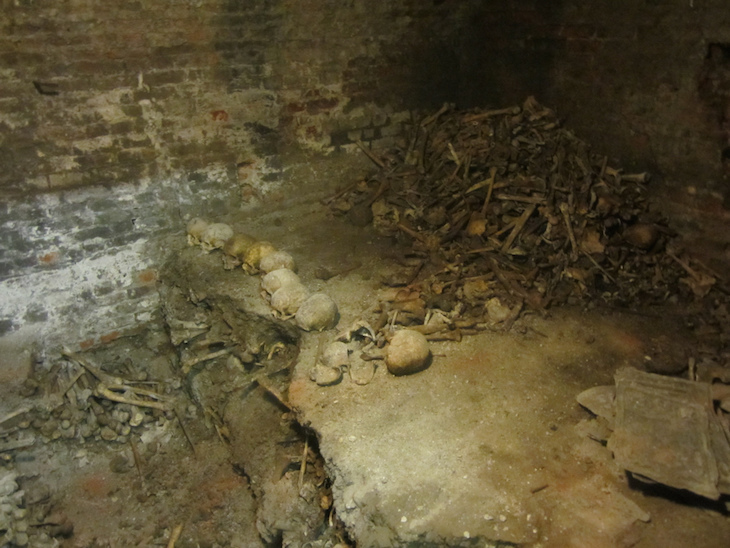
During the post-Blitz reconstruction of St. Bride’s, the preparatory team excavating the foundations found the charnel house. Apparently there are remains of 227 people from the 17th century alone! The original medieval skeletons are still there too. About 7000 bones had been put into categories and ‘laid out in a checkerboard pattern to an as-yet unknown depth’. Sorry, what? UNKNOWN DEPTH!?
Unfortunately, the charnel house isn’t generally open to the public. There are very occasional guided tours that you can attend, but for the most part it’s inaccessible. I was really disappointed, as that had been one of the big reasons I visited. However, I understand why it’s mostly closed off. There are a LOT of people interred in the ossuary, and constantly disturbing them would be a bit distasteful (and definitely will cause some bad juju, let’s be honest).
Coming down to the crypt was still absolutely worth it, though.
A History Lesson in the Crypt
As you descend the steps into the Crypt, the wall to your right is lined with paintings of the church going back through the centuries. It was really cool to see the history and evolution of St. Bride’s. 1666’s painting was simply the local area burning in the Great Fire of London.
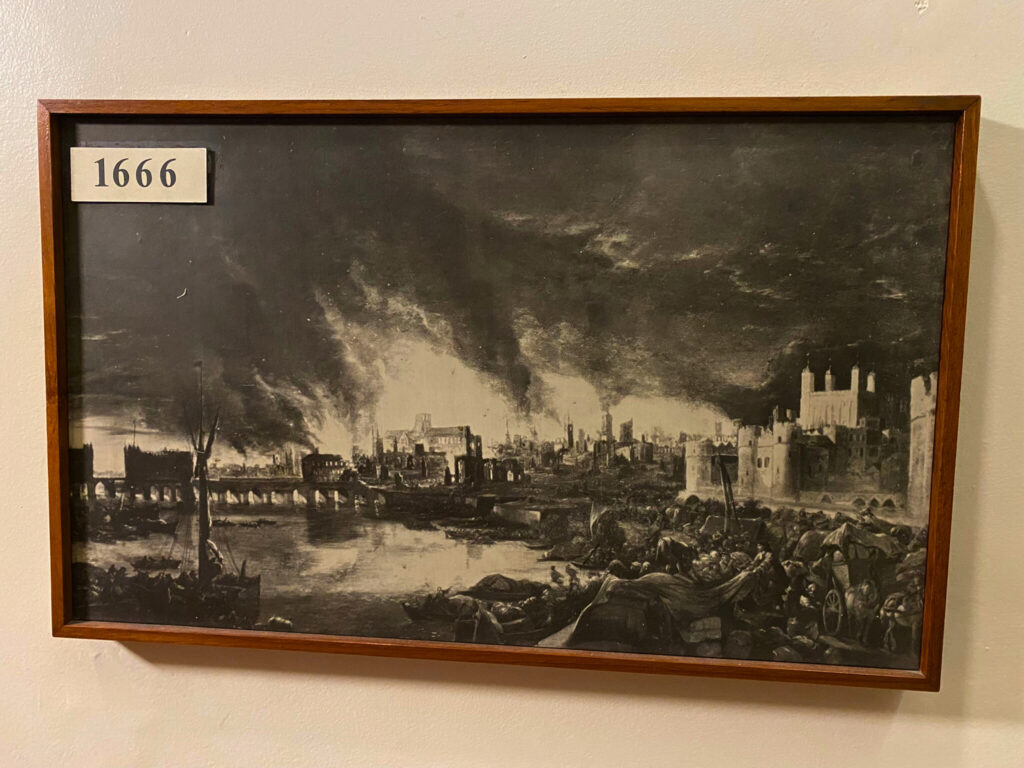
Down in the vestibule, I could see a room with tombstones ahead of me. To my right was the Crypt museum – I decided to start there and save the spooky part for last.
I mentioned earlier that all sorts of different faiths and cultures had landed on the St. Bride’s site at one point or another. The current church was stacked upon its predecessors like a stone lasagne. In the Crypt museum, you can see enduring evidence of them.
Ancient Stone Timeline
Inside the museum, remains of ancient walls still stand here and there, and have been incorporated into the new space. I spotted several signs that told me when each different wall was established. 12th century… 11th century… As I moved further into the room, the walls got older. The whole space hums with centuries of life, death, and secrets.
When you reach the back, you’re stopped from going any further by a more modern wall. Behind it you can see the most intact remains of the previous churches – thick stone walls with great gouges missing from the bombardments they endured.
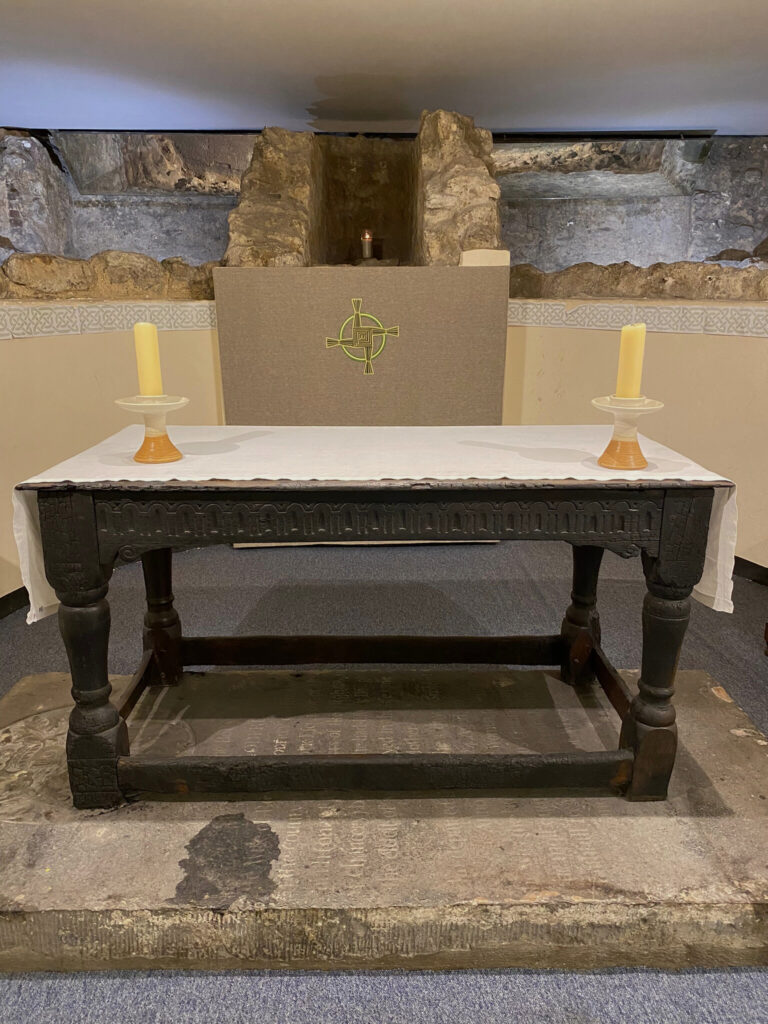
To the right, a mirror had been propped on the wall, so that you could peep the floor behind the modern half-wall. I shuffled and tiptoed as closely as I could to get a good view and saw… “Is that mosaic!?” I gasped to nobody.
The destruction of the Blitz had churned up a lot of history at St. Bride’s and this was a piece of it – a small section of Roman mosaic pavement from AD 180. That is just mind-bogglingly, unacceptably old. It’s believed that that pavement is the earliest evidence of building on the site.
There’s also a small altar placed at the back of the room, with the modern wall curving behind. It sits upon a memorial stone, which I found a bit worrying (what if they curse us??), and I assume small services can be held down there – there was enough room for a small audience to attend.
Broken History
The Crypt museum (maintained with assistance from Reuters and the Museum of London) is very cute. It’s laid out like a modern exhibition, but around the outcroppings of ancient walls. You’re continually reminded of everything St. Bride’s has been through by the many broken pieces of pottery, stone, and even church bells on display. My heart hurt to see the big chunk of church bell blown right out of the steeple during the Blitz.
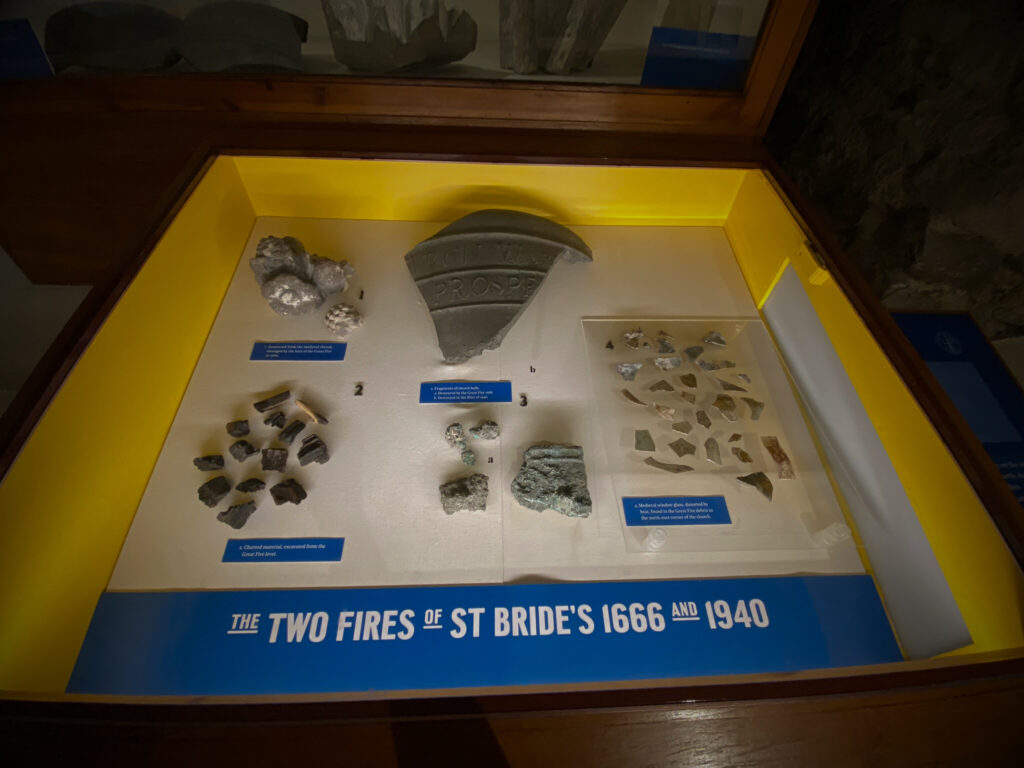
I’m also impressed by the organisation of the museum. You intuitively drift to your left as you enter the room, and that’s where you meet the oldest Roman artefacts and information. Moving along, you’ll find the story of St. Bride’s during the dissolution of the monasteries. I seem to bring this up a lot – our Henry did a thorough job of it, after all.
One of St. Bride’s former vicars, John Cardmaker, was burned at the stake during Mary I’s reign (Henry’s kids were just as ruthless), for the simple ‘crime’ of being a Protestant. Horrific!
Moving on, you learn about the Great Fire, the Blitz, the mighty damage St. Bride’s has sustained and survived over the centuries. I spent absolutely ages looking at artefacts and reading the information in the Crypt – there’s so much packed into a relatively small space! It was bloody interesting to find out just how much history this place had.
Again, I must thank the promise of skeletons and the memory of Mary Ann Nichols for leading me to St. Bride’s that day.

And finally, we come to the printing.
The Birthplace of British Journalism
Some of your ears might have pricked up when I mentioned that St. Bride’s sits on Fleet Street. Aside from demon barbers, Fleet is famous as being the centre of England’s printing, journalism, and publishing industries. Since 1500, the street has played host to many famous names including The Times, the London Gazette, The Guardian, and The Telegraph.
Wynkyn de Worde (oof, what a name) kicked it off by transferring his late boss’s business to Fleet Street in 1500, a stone’s throw away from St. Bride’s. Mr de Worde is actually buried in St. Bride’s, solidifying the church’s close relationship with the printing industry.
“THE AMOUNT OF HISTORY AND THE NUMBER OF SECRETS THAT HAVE BEEN THROUGH THE STREETS ARE IMMENSE.” – Alison Lee, CEO of the St. Bride Foundation
In its heyday, especially after the birth of newspapers in the 19th century, Fleet Street would literally vibrate from the many printing presses operating at once in the basements of its buildings. During the 1930s, most households in the country bought papers that were written and printed in Fleet Street.
The Printers’ Church
By the 1980s though, news outlets drifted away from the street as electronic presses gained popularity. Today there are still a few notable names left in the old journalist stomping grounds: The British Association of Journalists, Metro International, and the Associated Press still have offices in Fleet Street at present.

Despite the disappearance of the media and printers, St. Bride’s keeps a living reminder about the history of Fleet Street in the crypt museum. As a ~writer, I found it really fascinating. It’s so cool that St. Bride’s has such a random connection with that specific industry!
It doesn’t stop there. A lot of famous writers were parishioners of St. Bride’s, one of whom was Samuel Pepys. As in, the one whose diary of the plague and subsequent Great Fire is still famous today. His account actually covers the fire’s destruction of St. Bride’s. Richard Lovelace and John Evelyn are two other notable names, and the list goes on. I didn’t know any of this before I visited!
Journalists’ Altar
Back upstairs, there is a side altar in the northeast of St. Bride’s. Originally this altar held photos of journalists John McCarthy and Terry Anderson, who were held captive in Lebanon from 1985 until 1991. The church kept a constant vigil going for them, and all hostages, by lighting prayer candles and setting them on the so-called Hostages’ Altar.
That humble vigil became what St. Bride’s now calls the Journalists’ Altar – a permanent vigil for members of the press who have been killed, held hostage, or whose fates still remain unknown. It’s eerie to see the crowd of photo plaques displayed on the altar. Disturbingly, St. Bride’s has too many plaques to display all at once, and have to regularly rotate them so all of the people are seen.
It appears that St. Bride’s still feels a strong connection between themselves and the origin of the British press boom. They keep the safety of our reporters in their prayers always.
Run the Gravestone Gauntlet
You can only exit the museum from the same door you entered it, so I was back at the bottom of the stairs. The room I’d spied earlier, the one with the gravestones, beckoned to me irresistibly.
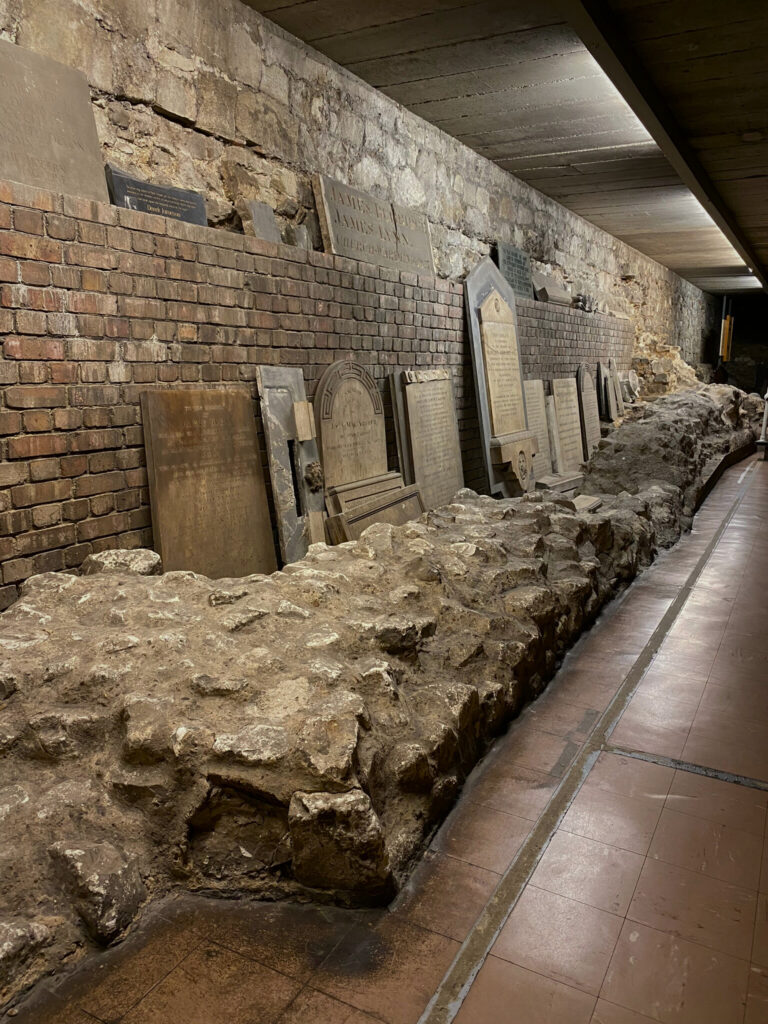
Turns out it’s more of a corridor, with more rocky outcroppings that were once ancient walls. Any load-bearing walls have been reinforced since, and the floor is of old (but not ancient) stone tile. Various tombstones are propped behind the rocky wall, lining the left side of the corridor. Further bits of old walls and broken grave markers lie with them.
I’ve tried in vain to find out more about why they’re there, as they don’t seem to mark out specific graves. Different eras are represented in the stones’ design choices, which just deepens the mystery.

The Iron Coffin
One of the most interesting things in the cellar was the iron coffin. It sat on a small wooden platform, with its lid mounted on hooks a ways above it. Over many years, the iron had rusted to a sick red-brown, with large chunks of it missing from the bottom of the coffin. Rust had also eaten holes through the lid in several places.
The edges of the coffin, where the lid had been pried off, looked devilishly sharp. Like when you’ve just opened a can (Editor’s Note: my older brother tried to lick the lid of a can once, cut his tongue open like an idiot). This thing looked like just being within three feet of it would give you tetanus.
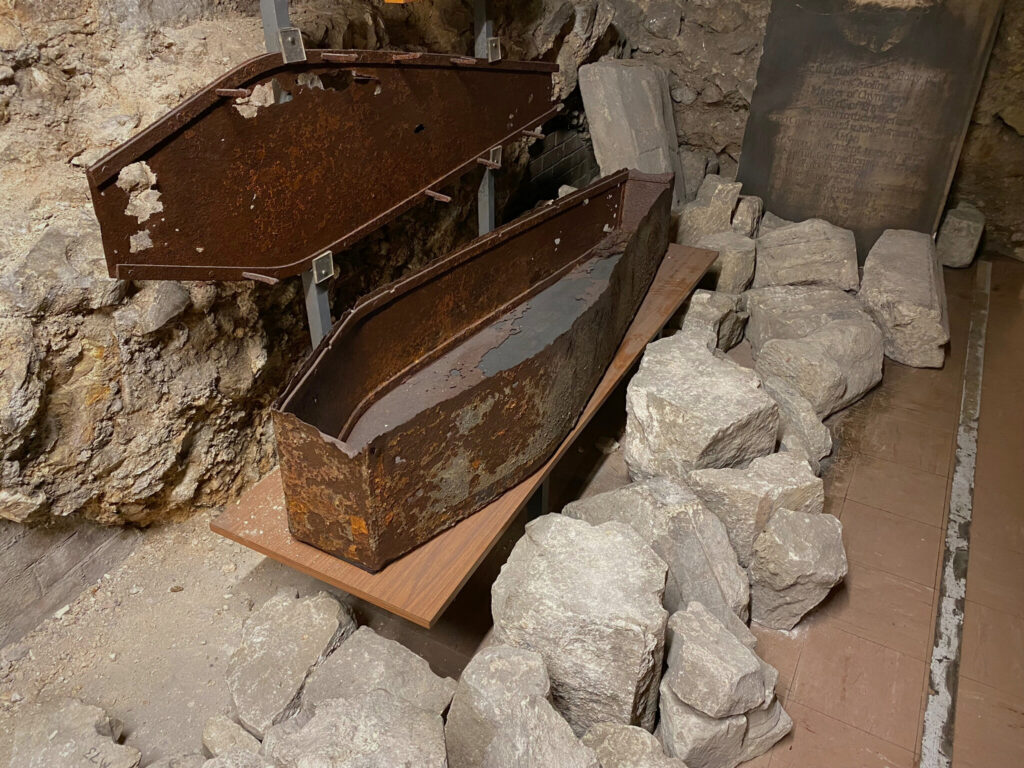
Obviously, I was intrigued and moved closer to read the information on a sign above the coffin. It turns out that the iron coffin existed to provide ‘Safety for the Dead’. I’ve talked before about the so-called ‘resurrectionists’ of the 18th century, who’d nab bodies from graves and sell them to medical researchers and schools. Obviously people were horrified at the thought of their gramps being disinterred and cut to bits post-mortem, and demanded a solution. Thus, the iron coffin.
The one at St. Bride’s is a design patented in 1818. Apparently, it used to be covered with a silver foil – I think you can still see bits of it, but I’m not an expert so don’t take my word as gospel. In this design, the lid is fitted with some vicious-looking spring clips that were activated by a flange (stop laughing!!!), which made the coffin much harder to get into.

Interestingly, ‘iron coffining’ wasn’t used for very long. First of all, churchyards wouldn’t even bury iron coffins; instead, they just took the body out and buried it unwrapped. Probably unsurprisingly, the Churchwardens of St. Andrew’s in Holborn were hit with a lawsuit. Their compromise was to charge extortionate fees for burying iron coffins, so it soon fell out of vogue. Sorry gramps, the body snatchers might get you after all.
My attention was drawn next by a cute bee emblem on the iron gate at the end of the corridor. The letter R was painted above the bee, so I assumed it had something to do with the next room – the Rothermere chapel.

St Bride’s Liminal Space
The underground chapel that you can visit in the Crypt of St. Bride’s began its life as the Blessed Virgin Mary chantry chapel. It was established sometime in the 14th century – the first record of it comes from 1361, where Blessed Virgin Mary was mentioned alongside two other chapels (St. John the Baptist and St. Anne).
The 1389 parishioners’ Guild was said to be so old that it was “ordained from a time to which memory of man extends not” (that’s slightly terrifying – if man doesn’t remember, WHAT WERE THE ORIGINAL BROTHERS?? VAMPIRES!?!?!)
After our old mate Henry VIII dissolved the Brotherhood of St. Bride’s, the chapels were turned into the burial vaults I mentioned earlier, the ones that were closed during the Cholera outbreak.
Despite being uncovered once again in the 1950s, the Rothermere chapel didn’t look how it does today until 2001. The Harmsworth family refurbished it to be a family chapel and to serve as a memory to the staff members of Associated Newspapers who had died during the course of the two World Wars (sticking to that journalism history).
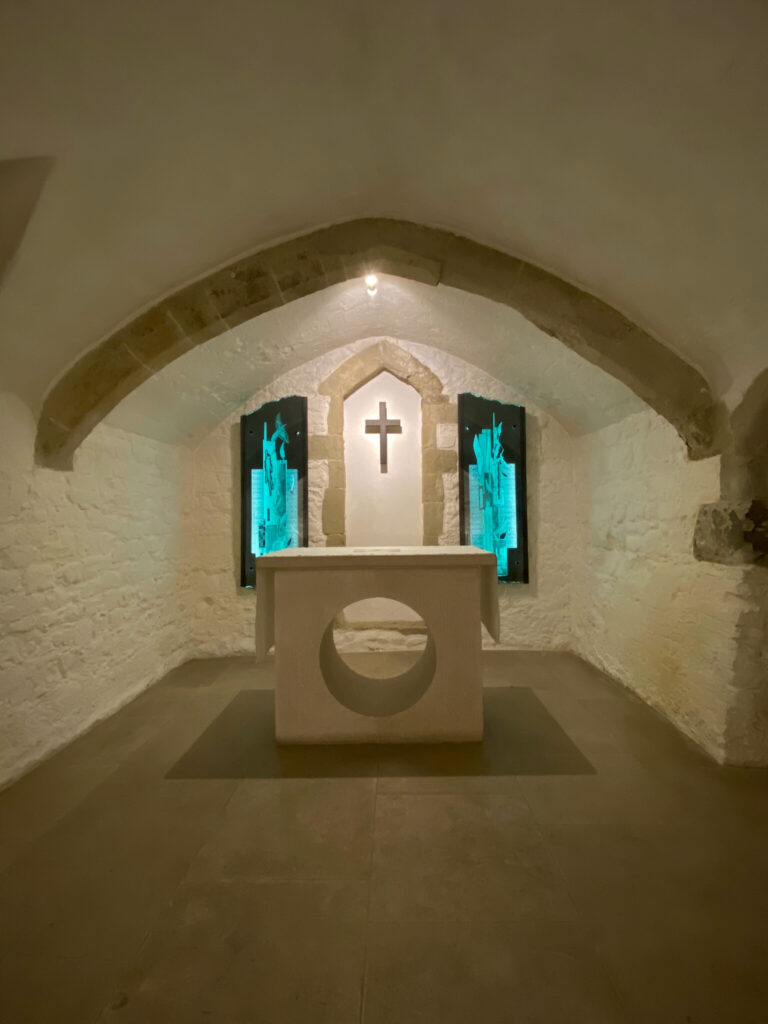
Now, you can wander into the chapel and have a look, sit for a while, or pray privately. They also use it for services like wedding blessings.
When I walked in, I was first a bit jarred by how much newer this part looked compared to the old artefacts in the crypt and museum. It does look fresh and new, but somehow also timeless and a bit liminal. It was very quiet, all noise from the streets above insulated by the thick stone walls.
I found it a little bit creepy (but in a cool way), I can’t really explain why. I really enjoyed it in there though and took a second to sit and chill.
Breaking News
A framed news article caught my eye near the bottom of the stairs to the crypt. Seeing that it was labelled ‘POLICE – GUILDHALL’ at the top, I became intrigued. What strange occurrence and awful crime happened that it warranted a newspaper article? An article that needed immortalising in a frame nearly two hundred years later?
It was printed in the Morning Herald on July 1 1830. A ‘decently-dressed’ man had entered St. Bride’s church, apparently intoxicated, and plonked himself on a two-seater pew. Problem was, that pew was already occupied. The man, a Mr Gunn, ‘had not occupied it two minutes before he fell asleep, and began to snore in the loudest and least harmonious manner possible, so as to distract the attention of all around him from the service that was going on’.

The article goes on to say that the Beadle did his best to rouse Gunn, eventually resorting to prodding him every time he started to snore. But ‘at length, the evil reached such a height that he [the Beadle] was compelled to remove the defendant and take him to the watch-house’.
As is often the case, some ‘not-my-jurisdiction’ passing around of Mr Gunn occurred. It was eventually decided that a compulsory sleepover at the watch-house would be sufficient punishment.
For a second after reading, I kind of stared at the framed article. Then I just laughed so loudly. I’m kind of glad no one was down there with me at that time. The article really tickled me, and I’m happy that I saw it after the more serious things, or it would’ve put me in a silly mood and I’d have been too distracted.
St. Bride’s Today
Today, St. Bride’s still functions as a conventional church, with services every Sunday at least. As well as the lovely crypt museum, St. Bride’s also runs regular events like an annual Christopher Wren talk, choir performances (they actually do webcast services, the first adult professional choir and London church choir to do so), and recitals of both voice and a variety of instruments (I even saw a LUTE one when I was browsing the website). Their weekly lunchtime recitals are actually free to attend!
If you’re really keen to get a close-up look at the church and its history, you can organise bespoke, private tours for you and your pals.

A Musical Church
Music is kind of a Big Deal at St. Bride’s. The choir are the pride and joy of the church, full of talented singers. As well as singing twice every Sunday, they also perform at special services and extra recital events. You can actually listen to them online here, along with loads of other performances and recitals by a huge variety of musicians.
I love that St. Bride’s regularly use music in their worship, even during sermons. Music is so deeply spiritual for many people and the church understands that completely.
St. Bride’s also has an incredibly impressive organ (STOP. LAUGHING.) from the John Compton Organ Company. While I was there, I didn’t actually see it – you won’t if you’re not looking for it as it’s housed inside a great oak console. According to the St. Bride’s website, you can see some of the pipes if you stand in the nave and look west, towards the Minstrels’ Gallery.
Boasting almost 4000 pipes, this organ is an absolute beast! It was crafted especially for the Rededication of St. Bride’s in 1957, after the post-war repairs were complete.

St. Bride’s got its name from St Brigid of Kildare, which is why the Guild’s medallions still bear a Celtic cross. It’s especially fitting that Brigid lent her name to this church, as she was known to be a great lover of music and poetry. It seems her spirit still flows through the church to this day.
Peace & Quiet
Every weekday between 4 and 5pm, St. Bride’s has what it calls a ‘silent space’. During this hour, the church is softly lit with candlelight, and any usual work stops, creating a peaceful sanctuary. Anyone is welcome to come to the silent space, regardless of faith (or lack of).
You can sit for a while and reflect, practice mindfulness, pray, or just sit and be. I think it’s a beautiful idea, especially in a city as hectic and cramped as London.
Next time you’re in Fleet Street, go and pay your respects to Mary Ann Nichols. Then stay at St. Bride’s for a while and get your fill of beauty, history, and the macabre. Bonus: the church and the museum are free to enter!

